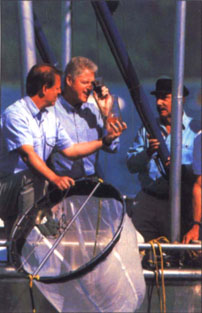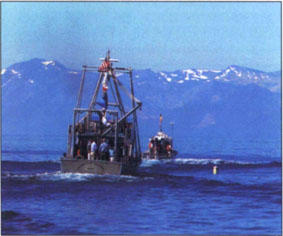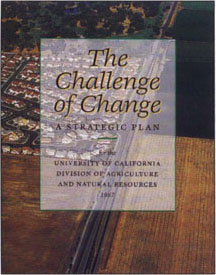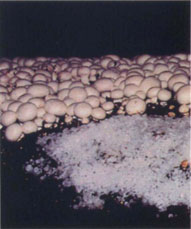All Issues
Science Briefs
Publication Information
California Agriculture 51(5):4-5.
Published September 01, 1997
PDF | Citation | Permissions
Full text
UC scientists alert Clinton to Lake Tahoe's woes
UC research at Lake Tahoe will receive an injection of federal funds as part of commitments made by President Bill Clinton during the Lake Tahoe Forum.
In July, the President and Vice President Al Gore turned the national spotlight on this once-pristine environment — now imperiled by the multiple effects of urbanization and tourism. The lake's clarity has diminished 33 feet in the last 27 years, according to the UC Davis Tahoe Research Group.
During his visit to Lake Tahoe, Clinton pledged $26 million over the next 2 years in addition to the $24 million in federal funds already budgeted for the environmental restoration of the Lake Tahoe basin.
One result is that UC Davis lake ecologist Charles Goldman and water quality specialist John Reuter were awarded an $880,000 grant by the Environmental Protection Agency and the National Science Foundation. The grant will enable Goldman, founder of the Tahoe Research Group, and Reuter, director of the Lake Tahoe Interagency Monitoring Program, to develop computer modeling tools to evaluate how watershed improvements benefit water quality.
Charles Goldman shows Bill Clinton and Al Gore how to test water clarity during a 40-minute tour of Lake Tahoe in the UC Davis research vessel (shown at left).
Each year 20 million people visit the Tahoe basin, most with automobiles that spew nitrogen into the atmosphere. Much of that nitrogen ends up in the lake, helping feed algae growth. In addition, urbanization of the Tahoe basin has eliminated 75% of its marshes, 50% of its meadows, and 35% of its stream zone habitat and wetlands, according to the Tahoe Research Group. The reduction of these critical habitats decreases filtration of nutrients; the nutrients then enter the lake and fuel algal blooms.
During his nearly 40 years of studying Lake Tahoe, Goldman has observed the increasing growth of algae in the water and on the shoreline rocks. This algae is gradually turning the clear co-balt-blue waters a cloudy emerald-green.
The Tahoe Research Group has been able to reconstruct Lake Tahoe's history since 1850 by studying deep lake sediment cores. After the devastating logging activities of 1865–1890, the scientists saw signs of significant recovery from the turn of the century until the dramatic increase in urbanization beginning in 1960. This finding gives hope that restoration activities can be successful. However, if action isn't taken within a 10- to 15-year window of opportunity, the lake could permanently become a lake of ordinary clarity, with visibility of 40 feet or less.
In addition to the sediment core study, the Tahoe Research Group is studying sediment transport and erosion modeling, nutrient cycling, atmospheric deposition, best management practices and treatment of surface runoff, marina dredging, water quality of other lakes and reservoirs in California and Nevada, mercury left in streams by gold mining, fisheries habitat enhancement and the influence of the fuel additive MTBE on lake water quality and aquatic life.
Lake Tahoe was one of several places studied in the Sierra Nevada Ecosystem Project (SNEP), which examined conditions for the entire Sierra Nevada. “Tahoe may provide a pathway for an integrated ecosystem approach to new management and monitoring for the wider system,” says Don Erman, director of UC's Center for Wildlands and Water Resources, who headed SNEP.
Why select the Lake Tahoe ecosystem to examine and address the issues common to most of the Sierra Nevada and much of the West? The incredible beauty of Lake Tahoe is only part of the answer, Erman told participants of the workshop hosted by Gore.
In addition, he said, “investigators of the basin have created an exceptional baseline of scientific data. It extends over a long time and provides critical knowledge to both understand the past and evaluate future changes. Second, the society here in the basin has gone through years of effort and discussion to clearly define their common goals. They have in the process also gained an understanding of the basin as an eco-system of many interacting parts in which environmental quality and human quality of life are united.”
Restoration efforts in the basin are focused not only on keeping the great variety of plant and animal species, but also the patterns and processes over a large landscape, Erman said.
Strategic plan published
The Division of Agriculture and Natural Resources (DANR) has published its new strategic plan, “The Challenge of Change.”
“DANR's strategic plan provides a framework for making critical decisions at all levels of the Division regarding how we spend our money and our time and how we organize ourselves and conduct our work,” DANR vice president Reg Gomes says in the report's preface.
To obtain a copy of the 24-page document, call the Office of Program Planning and Evaluation at (510) 987-0066.
New strain of old disease threatens mushrooms
Walking along the tiers of beds and trays in mushroom houses this spring, Santa Clara County growers found green mold stretched across empty patches where the round, white tops of button mushrooms should have been.
A new strain of an old disease is threatening Santa Clara County's number one agricultural product. Button mushrooms, Agaricus bisporus — valued at $30 million to $35 million a year for the county — have been infected with Trichoderma harzianum Th-4, according to Santa Clara County farm advisor María de la Fuente. She anticipates T. harzianum Th-4 will reduce this year's mushroom yields by 25%.
T. harzianum Th-4, is a very aggressive new strain of an old disease caused by a fungus. Green mold, the old disease, spreads slowly and is usually associated with improperly processed compost. The new strain has appeared even in properly processed compost and proven to be severe and fast-spreading in the mushroom industry in Canada and Pennsylvania, says de la Fuente. Pennsylvania's yields fell nearly 50% during its first year of infection, she said.
In early April, a Santa Clara County grower noticed the rapidly spreading mold and called de la Fuente. CDFA's Plant Pest Diagnostic Center in Sacramento isolated the aggressive strain from the samples she sent. The results were confirmed by highly specific lab tests at two other internationally recognized institutions. By June, the grower had suffered a 40% yield loss.
“Recently, I sampled several farms in the Santa Clara County area, others in Monterey, Santa Cruz and San Mateo counties, and found that they all have the disease,” she says.
After 2 to 5 weeks of an apparently normal start, sections of a tray can turn green with Trichoderma spores. Initially a few isolated tray sections are infected, but soon it becomes epidemic, commonly infecting 30% of a mushroom house, and sometimes making cultivation cycles of the entire house unprofitable.
The problem can be exacerbated by mites, another common pest, but they aren't the only ones spreading Trichoderma spores. Wind-car-ried dust particles, insects, contaminated hands, clothing and tools of workers can contribute to the spread of spores.
Mushroom growers are covering patches of T. harzianum Th-4 with salt to stop the spread of the mold.
Another strain of T. harzianum is used in agriculture as a biocontrol agent to kill soilborne pathogens. De la Fuente says, “I think that the scientific community needs to look at whether this widely used strain of Trichoderma harzianum is not mutating or adapting and causing this disease on mushrooms.” However the source of the problem has not been determined.
De la Fuente suspects the new disease arrived last year Santa Clara County because production yields dropped from 145 tons per acre in 1995 to 133 tons per acre in 1996.
California growers may be granted a special use of the fungicide benlate (Benomyl) to treat the planting material, called spawn, to stem the spread of the disease. Currently use of the fungicide on mushrooms is restricted to application after the crop is established. To ease this restriction, de la Fuente recently requested the California Department of Pesticide Regulation's endorsement for the petition prepared for the Environmental Protection Agency (EPA) for a Special Local Need Registration Section 24(c) of benlate to treat the spawn before planting. EPA has granted a similar permit to the state of Pennsylvania. One problem with using this fungicide is that there is a high risk of killing the mushroom, itself a fungus. To reduce the risk, she will advise growers to treat the spawn right before planting and to make sure they don't overdose.
“The potential loss for California mushroom farmers because of this disease is sizable,” de la Fuente says, “and a benlate spawn treatment will have a significant impact in reducing this threat as it did for Pennsylvania growers.”
—Ed.








